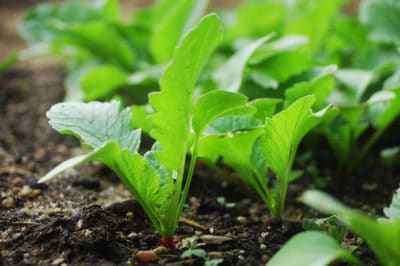Planting for Production
Radishes grow so quickly that they need optimum soil and water conditions. Work aged manure or organic fertilizer into your soil. Radishes need phosphorus, phosphate, potash, sulfur and boron but have less need for nitrogen, which promotes leaf rather than root growth. They prefer a pH of 6.5 to 7.0.
Choosing Varieties
Many radishes can be grown at different times of the year. Generally, short maturity dates are better for summer and longer dates for spring and fall. Here are popular choices:
- Cherry Belle (22 days)
- Sparkler (25 days)
- White Icicle (27 days)
- Crimson Giant (30 days)
- French Breakfast (30 days)
- China Rose (55 days)
- Daikon (60 days)
Spring and Fall Planting
Radishes are very cold hardy. In the spring you can plant as early as four to six weeks prior to the average date of the last frost. Sow seeds about one-half to one inch deep and one inch apart. Make sure they are in full sun all day. Begin planting fall radishes in late August.
Summer Planting
You can continue to plant radishes to the end of June. Put the seeds in the refrigerator for about a week prior to planting. Plant in areas that get morning sun and keep them well-watered. Keep them growing fast and harvest the minute they’re ripe. These radishes may be hotter than spring or fall plantings.
Winter Growing
Since radishes take so little room, you can even grow them in winter in many areas. Cover a garden bed with a portable plastic mini-greenhouse or grow them in a cold frame. Grow them in containers that can go outside during the day and come into an unheated garage at night. Plant succession crops in different containers.
Manage Your Crop
No matter when you plant radishes, it’s vital to keep them growing quickly. Radishes get hot if they grow slowly or are left in the ground too long. Harvest within a day of the maturity date even if they seem small. The flavor will be better than if left to grow larger. However, winter radishes will keep in the ground for a few weeks.
